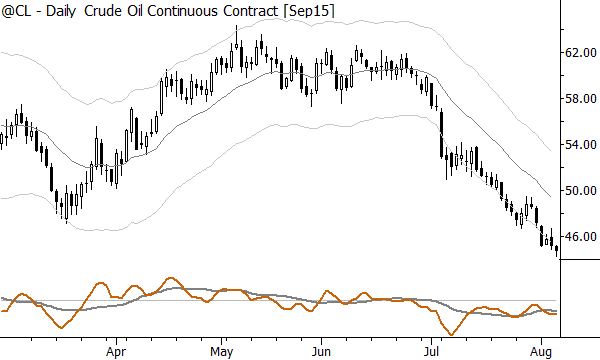Slip and slide (along the bands)
Effective trading patterns are usually simple. The more complicated an idea is, the more likely it is the result of trying to fit very random data (i.e., the market) into a preconceived mold. I think many of the patterns and ratios of traditional technical analysis are the result of very misguided Procrustean "analytical techniques"--this is one reason they look so good in the past, but don't have that much utility at the hard right edge of the chart.
First of all, let's take a quick look at the current daily chart of crude oil. I've written a bit about crude oil recently, but the lesson today is about the character of the trend. Notice how crude oil is pressing into the bottom Keltner channel without any real retracements:

This pattern can be dangerous, and understanding it can save you a lot of grief. I probably need a better name for it, but I've taken to just calling it "slide along the bands", because that's what the market does. In bullet points, here are the main concepts:
- Markets normally move in alternating periods of with-trend movement (up or down), interspersed with pullback against the trend. The normal way markets move is in a zig-zag, which is why trading pullbacks can be such an effective trading strategy.
- Sometimes this pattern gets short-circuited, and the market does not pull back. There are many ways this can happen, but in one particular case, the dominant group pushes the market in the trend direction at the same time volatility dries up.
- This creates an interesting situation in which the market "drips", "bleeds", or "slides" higher or lower (depending on the trend direction). If we use properly calibrated bands, we can see this pattern when the market just presses into one band and sits there while it continues to trend.
You can find other examples of this pattern (Silver in 2010 and 2011; Wheat in 2014; US Stocks 2010, 2012, 2013; Nasdaq stocks around and after 2000, Crude Oil 4Q 2014, etc), and it's worth spending some time looking at how this pattern ends, and also thinking how you might (not) trade it. I covered this pattern briefly in my book. Here's what I said about it there:
One special case of shallow retracements is more common on intraday charts than on higher time frames: sometimes an extremely strong trend is unable to pull back at all; the absence of any clear trend pattern is a pattern in itself. Prices may either move higher in a series of tight, stair-step trading ranges, or they will press against the upper channel and slide along that band as the market grinds higher. These can be treacherous patterns to trade. While these patterns do point to exceptionally strong imbalances and also to very strong trends, the lack of significant pullbacks makes it difficult to position in the trend at advantageous prices. In addition, these types of trends often feature the occasional large spike against the trend, most likely driven by anxious traders exiting trades near the edge of shallow pullbacks. These spikes can make it difficult to precisely define risk in with-trend entries.
This pattern is the proverbial double-edged sword. On one hand, the market can go much further than we might expect. When you are fortunate to be positioned on the right side of such a move (as my research clients currently are short), the best thing to do is to not get cute: maintain a correct stop and tighten that stop every 2-3 bars as the market makes new extremes. Don't look at P&L, and don't over think. Let the market tell you when to get out by hitting your stop.
However, this pattern does bring some risks. When it ends, it often ends in a volatile spike against the trend. You absolutely must respect those stops, and we cannot be upset if we are stopped out in noise. When this pattern ends, the market is probably going to become very emotional. The market can be emotional; you, as a trader, cannot.
So many times, in trading, our entire job description boils down to one simple directive: don't do anything stupid. Don't make mistakes. Understanding this simple pattern can help you avoid many mistakes and navigate this difficult trading environment.



